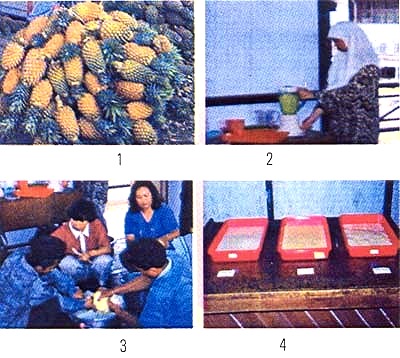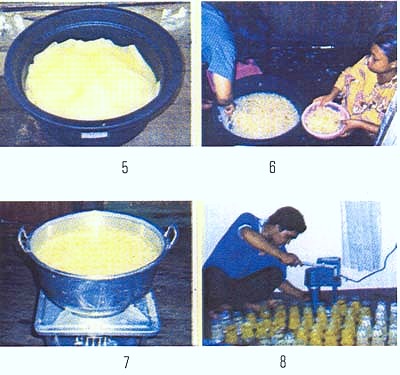Pineapple (Ananas comosus) or popularly known as “Pinya” here in the Philippines, is the common name for a tropical plant and its edible fruit, which is actually a multiple fruit consisting of coalesced berries. The Spanish introduced it into the Philippines in the early of 19th century. Pineapple can be consumed fresh, canned or juiced and can be used in a variety of ways. It is popularly used in desserts or salads, usually tropical fruit salads, jams, yogurts, ice creams, various candies, as a complement to meat dishes and in fruit cocktail. The popularity of the pineapple is due to its sweet-sour taste. Pineapple is an excellent source of manganese and vitamin C.
The productivity of pineapple does not necessarily yield good price. At harvest season, the price is very low and lots of wastes are incurred in the market place and producing centers.
To overcome this problem, a technology has been developed to process fresh pineapple into Nata de Piña. By adding Acetobacter xylinum, the sugar component in pineapple juice can be changed into a substance which is called Nata de Piña.
Processing of Nata de Piña
Materials:
- Pineapple juice, 10 liters
- Diammonium phosphate (DAP), 30 g
- Sugar, 4.8 kg
- Glacial acetic acid, 0.2 liters
- Acetobacter xylinum, 1 liter
Equipment:
- Blender
- Knife and cutting board
- Siever
- Pan and stirring spoon
- Stove
- Plastic tray
Processing (Fig. 1 and Fig. 2):
- Prepare all the materials
- Mix and boil pineapple juice, DAP, sugar, and glacial acetic acid.
- Let the juice cool in a plastic tray, and then add starter Acetobacter xylinum and cover with paper.
- Fermentation lasts for 14 days and nata layer will be formed thereafter. Cut the nata into size 1 x 1 x 1 cm, wash and boil.
- Soak the nata in water for one night, and change soaking water repeatedly to eliminate acid taste.
- Add 40% sugar solution, essence, and benzoic.
- Package nata in cups covered with plastic.

Figure 1 (1-4): Stages of Nata de Piña Processing

Figure 2 (5-8): Stages of Nata de Piña Processing
Sources: www.agnet.org, wikipedia.org; Photos: www.agnet.org